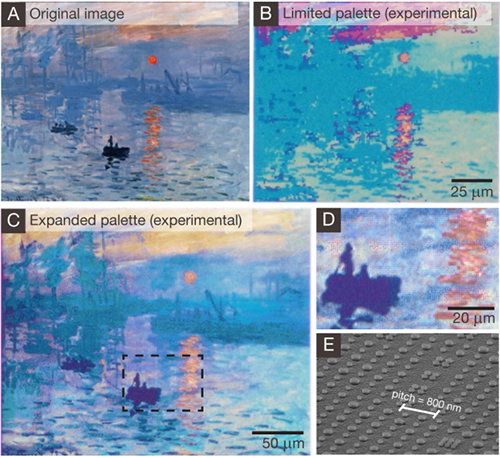X-RAY RUNS: Apply for Beamtime
2017 Nov 1 - Dec 21
2018 Feb 7 - Apr 3
2018 Proposal/BTR deadline: 12/1/17
2018 Apr 11 - Jun 4
2018 Proposal/BTR deadline: 2/1/18

This past November ten young innovators made it to EmTech Singapore’s Innovators Under 35 list, selected from over 100 applicants from Asia and Australasia [1]. One of the judges of the competition noted that "This list represents a snapshot of Asia's up-and-coming technologists and innovators. It was a challenge to narrow down 100 names to the 10 you see here."
One of them was recent CHESS user Shawn Tan, a Research Scientist at the Institute of Materials Research and Engineering, A*STAR. Their summary cited that Tan recently demonstrated the world’s smallest reproduction of a painting in full-color, which represents a leap in resolution beyond the state-of-the-art. Shawn is currently the Assistant Head of Technology Development at IMRE, applying his background in bio-engineering to the field of nanoplasmonics, a relatively new field focused on understanding and manipulating how light behaves at the nanometer-scale.
Tan’s current work revolves around super-resolution plasmonic colour printing. Shawn received his bachelor’s degree in Biomedical Engineering from Duke University and both his master’s and doctorate degree in Biomedical Engineering from Cornell University. At Cornell he developed novel ways to understand and engineer DNA-based nanoparticle assembly. During his graduate career he visited CHESS repeatedly over the past five years, working in Dan Luo’s group and collaborating with CHESS scientist Detlef Smilgies on projects using x-rays for in-situ characterization of DNA-nanoparticle formations at air-liquid interfaces, ionic effects on entropy-driven nanoparticle self-assembly, and regulation of gold nanoparticle monolayer spacing by DNA.
Taking his diverse expertise and experience to the next level, Shawn is now leading a cross-disciplinary effort on interfacing DNA programmability with high-resolution patterning and addressability for which he was awarded a three-year Career Development Award by the Agency for Science, Technology and Research (A*STAR) Joint Council Office in Singapore. In one presentation he gave entitled “Nanoplasmonics: Redefining the Limits of Colour Printing”, Shawn posited “Imagine the vibrant beauty and the subtle brush strokes of Claude Monet’s Impression Sunrise masterpiece that could fit, not just in the palm of your hands, but in the width of a single strand of your hair.” He described how this is now possible with plasmonic colour printing, which relies on the phenomenon of plasmons in metal nanostructures rather than decades-old technology involving dyes and pigments. In a recent publication he describes with collaborators the first plasmonic palette utilizing color generation strategies for photorealistic printing with aluminum nanostructures, expanding the visible color space through spatially mixing and adjusting the nanoscale spacing of discrete nanostructures [2]. They point out that advances such as these could pave the way for a new generation of low-cost, high-resolution, plasmonic color printing with direct applications in security tagging, cryptography, and information storage.

Figure 4 from ref [2]: Reproduction of Monet’s Impression, Sunrise using the expanded palette by color toning and mixing strategies. (A) Original input image adapted with permission from Musee Marmottan Monet, Paris, France / Giraudon / Bridgeman Images. (B) Reproduction using only the limited palette of “primary plasmonic colors” falls short of the original image. (C) Realistic reproduction of the artwork using an expanded palette of colors, allowing for the subtle variations in tone and color in the original to the replicated. (D) Higher magnification image of dotted box in (C) highlighting the brush strokes that are resolved in the plasmonic painting. (E) Tilted SEM image of pixels showing how the colors observed in the plasmonic painting are the manifestation of a predefined structural layout.
References:
[1] Asian Scientist Magazine at: http://www.asianscientist.com/2014/11/topnews/tr35-emtech-singapore-2015/
[2] Shawn J. Tan, Lei Zhang, Di Zhu, Xiao Ming Goh, Ying Min Wang, Karthik Kumar, Cheng-Wei Qiu, and Joel K. W. Yang, “Plasmonic Color Palettes for Photorealistic Printing with Aluminum Nanostructures,” Nano Letters 2014 14 (7), 4023-4029; DOI: 10.1021/nl501460x.
Submitted by: Ernest Fontes, CHESS, Cornell University
01/14/2016
